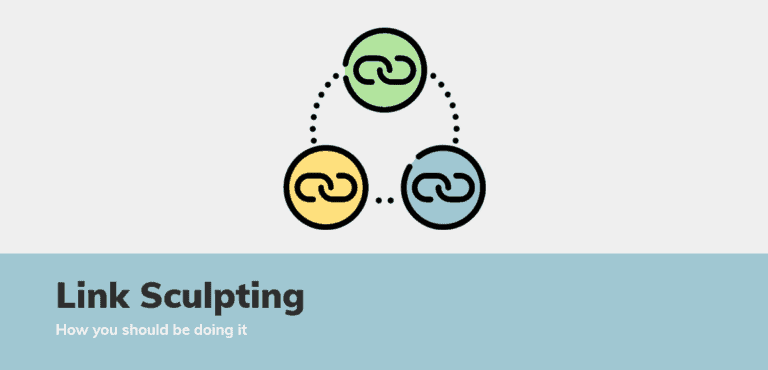Link sculpting, also known as PageRank sculpting, has been debated many times across many different social channels. The thing is, each side has their own valid points (and presumably data) to back up their cases.
First of all, what is link sculpting?
Link sculpting is the act of manipulating your website’s PageRank by controlling the flow of link juice your site’s link juice. This is done through adding the “nofollow” attribute tags to links that they don’t want juice to flow to, while excluding it from the pages that they want to rank for.
The most common way to do it is through adding nofollow tags to internal links to selective distribute your link juice. Alternatively, nofollow tags are added to external links to prevent link juice for exiting your website.
Let me share with you the main points that each side brings.
Against Link Sculpting
- It doesn’t work because Google is smart enough to know that SEOs are trying to sculpt. Therefore they devalue any efforts to retain link juice within a website
- Google has claimed that they might ignore nofollow links, making PageRank sculpting efforts a waste of time
- Link juice does not retain on your page even if you nofollow your internal/external links. For every link, link juice will flow from one page to another. Nofollowing your links will just mean that it flows out, but you don’t pass it to the other page. Essentially, link juice “disappears” (Matt Cutts)
For Link Sculpting
- It works because you can channel the link equity from your most powerful pages to weaker posts to increase its rankings. This way, you spend less on backlinks as your posts are powered by internal links
- It prevents link juice from flowing out of the website, and you can cycle it across different internal pages
- It improves crawl efficiency as Google’s bots will not crawl low-value pages
Here’s what I think about PageRank Sculpting
Well, both sides of the argument do bring valid points. Logically, if Google honours nofollow links, your link juice would not be channelled to other pages. However, it does make sense that you’re just wasting your time if Google ignores your nofollow links.
As much as I would like to choose a side, I’ve yet to see these discussions provide data and tests on whether it worked for them.
Personally, my efforts in link sculpting have seen improvements in keyword rankings. However, it wasn’t a controlled test so it could have been anything that caused the increase. Furthermore, it was only 2 sites, an insufficient sample size to come to a conclusion.
So what should you do?
Whether it works or not, I doubt link sculpting will have any adverse effects on your site. I say, just do it. If it works, good for you. You don’t want link juice being passed to your low-value pages anyway.
If it doesn’t, well then it doesn’t matter. A small website would take less than an hour to link sculpt anyway.
Just make sure to do it the proper way.
How to do link sculpting properly?
As Google might not honour nofollow links, there’s really no harm in link sculpting. But this doesn’t mean that you should be link sculpting to only pages that you want to rank.
What you want to do is to nofollow to pages that are of low value. Such pages are your
- Category pages
- Tag pages
- Author pages
- Date pages
- Archive pages
- Terms of Service/Terms and conditions pages
- Privacy Policy pages
Basically taxonomy pages, archive pages, or your TOS & privacy policy pages. The reason for this is that these pages merely extract information from your main posts. This creates duplicated and thin content across your website and devalues it.
Not to forget, search engine spiders have set limited crawl budgets for different websites. No matter how big or small your website is, it is always best to help these bots crawl your websites efficiently, making sure that your content is found and indexed.
And the way to do this is to link sculpt. Use nofollow links to nofollow the abovementioned pages.
What happens if I selectively choose internal pages to link sculpt?
Link sculpting, if not done correctly, will actually do more harm than good for you. As Google has already mentioned that link juice “disappears” when you nofollow a link, you’re actually wasting the opportunity to disperse it around your site.
Let me give you an example.
If you’re writing an article, and that article internally links to pages A and B, both related to what you’re currently writing about.
Page B is already on the first position, while Page A is at position 11. You know that sending an internal link with link juice to page A will push it to page 1.
And in that attempt, you nofollow Page B in hopes that all the link juice will be transferred to Page A. Instead of spreading 100% of the link juice to Page A, you’re effectively transferring only 50%, while wasting the other 50%.
That transferred 50% is then spread out to other internal links in page A, which you selectively link sculpt as well. And the cycle repeats itself.
You’re removing the link juice that you could have possibly had. So instead of doing good, you’re actually harming yourself.
That’s why it’s important to know how to do PageRank sculpting properly.
Nofollowing external links
Now while internal link sculpting is more often talked about, let’s not forget that there are also discussions about nofollowing external links.
SEOs have been nofollowing all their external links in their attempt to keep the link juice within their website. Although this method used to work, it no longer does now.
Why?
Again, because Google might not honour nofollow links. Google knows what you’re trying to do. And they’re trying to protect legitimate publishers by fairly sending link juice over to their websites.
Publishers produce content for search engines and allow Google to earn through the Google Display Network, that’s why it’s essential to keep publishers’ interest at heart.
By nofollowing links to authority websites, you’ll just be ignored. Plus, it’s bad for your on-page optimisation. To have good on-page optimisation, you will need at least 1 followed external link.
How should you nofollow external links
Firstly, if you have a comment section, make sure to nofollow all the links there. There’s no benefit for your article by linking to your commenters’ websites apart from identifying who they are.
Doing this also helps mitigate comment spam.
Next, do not include a nofollow tag to all your external links to high authority websites. Authority sites are there for you to reference from. They are established leaders in the niche. Linking to them helps build your website’s credibility.
What happens when you are citing from a non-authority site?
Think about why the nofollow tag was invented. It was to prevent spam from low-quality and spammy sites. Unless you’re citing from these types of websites, there’s no harm in “” dofollowing”” your links to non-authority sites.
If you’re really doubting the website, either look for an alternate source, or you can choose to add a nofollow tag.
Conclusion
Although there are pros and cons to doing internal/external PageRank sculpting, if it’s done right, it will benefit you.
However, if not done proper, you risk doing more harm than good. Therefore, it is always important to understand what you’re doing before actually doing something.
Anytime you are unsure, Google for your answer. There is a wealth of sources available for free online. Read the opinions from different experts, and objectively decide what’s the best action you should take.
Are you planning to try out link sculpting?




